Italy begins to emerge from Europe's longest lockdown with limited reopenings
Millions are returning to work as schools remain closed; Amy Kellogg reports from Florence.
Get all the latest news on coronavirus and more delivered daily to your inbox. Sign up here.
After weeks under strict coronavirus lockdown measures, most European countries are cautiously easing their societies back to some semblance of daily life.
The European continent has recorded more than 1.6 million confirmed COVID-19 cases — with the highest number of infections seen in Russia, the United Kingdom, Spain, Italy and France.
The continent also has seen more than 155,000 deaths attributed to the respiratory virus.
CLICK HERE FOR FULL CORONAVIRUS COVERAGE
Governments are slowly reopening schools and shops while delicately balancing the possibility of a second wave of infections.
Here's how European countries are lifting their coronavirus lockdowns:
ALBANIA
Population: About 2.84 million
Coronavirus cases: At least 880
Coronavirus deaths: At least 31
Albania’s continued success in controlling the spread of COVID-19 means that half of its nearly 3 million people can now enjoy more freedom in so-called “green zones,” while life went on almost as normal for the other half.
In mid-April, the government began to loosen some of its tight restrictions by allowing some shops, courts and taxis to resume business.
People in green zones – having had either very few cases or none at all – are now allowed to leave without much of a curfew. Those in red zones, where infection rates remain higher, are still under a strict 5:30 p.m. to 5 a.m. curfew.
In early May, barbers, hairdressers and dentists were allowed to reopen. The wave of clients was handled by having them wait outside their shops or come by appointment.
Cafes and bars are set to open next on the condition they only serve customers outdoors.
The country's move to reopen the economy will be taken in two-week stages, provided there is no surge in new cases, hospitalizations or use of intensive care units. Lockdown measures could be reapplied as an “emergency brake” if necessary, the government warned.
ANDORRA
Population: About 77,000
Coronavirus cases: At least 758
Coronavirus deaths: At least 48
Andorra, the landlocked nation wedged between France and Spain, controlled the spread of novel coronavirus by implementing lockdown measures early on.
In mid-April, the government adopted a unique way of easing lockdown restrictions that would allow people to leave their homes on specific days.
Residents who live in even-numbered homes are allowed to go out on even days, while those who reside in odd-numbered homes on the odd days, Euro News reported.
However, for residents whose homes don’t have a number, if the name of the occupants begins with A through M, they are allowed out on even days, while odd days are for those whose names begin with N-Z.
Residents are allowed to leave their homes – on their specific day – for an hour to exercise or for essential shopping and must remain a distance of at least 13 feet from others and wear face masks. Specific times were also allotted for these activities.
"This is not 'no restrictions' but rather [phasing in] exceptions to the lockdown,” Health Minister Joan Martínez Benazet said, according to Euro News.
The government has not announced any plans to reopen its economy.
ARMENIA
Population: About 2.96 million
Coronavirus cases: At least 3,718
Coronavirus deaths: At least 48

A medical worker in a protective suit checks the body temperature of a person at a checkpoint in the city of Vagharshapat, during a lockdown due to coronavirus outbreak, in Armenia, March 16, 2020. (Hayk Baghdasaryan/Photolure)
Armenia is slowly reopening its doors despite a recent rise in confirmed COVID-19 infections.
The country’s state of emergency expires May 13; however, the government allowed certain businesses to reopen in mid April, including fishing mining, financial and insurance services, agriculture and cigarette production.
Certain shops, restaurants and bars, beauty salons, and dry cleaners reopened in early May. However, malls, trade centers, markets and all schools and colleges remain closed. Public transport remains suspended.
SWEDEN CRACKS DOWN ON OVERCROWDED BARS AS CORONAVIRUS CASES RISE
AUSTRIA
Population: About 9 million
Coronavirus cases: At least 15,997
Coronavirus deaths: At least 624
Austria was among the first European nations to restrict the movement of its nearly 9 million citizens. On March 16, the government implemented strict restrictions across the country. Restaurants, bars and sporting events were shut down, with only supermarkets and food delivery services available.
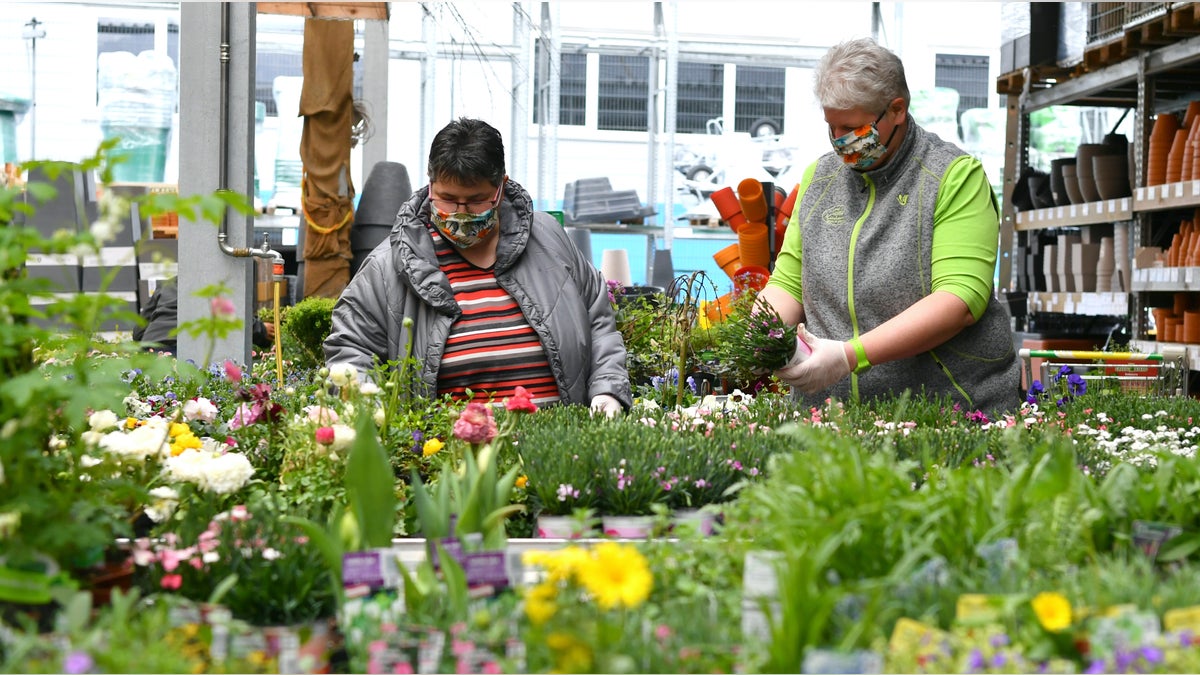
People with protective masks look for flowers in a garden center in Saalfelden, the Austrian province of Salzburg, Tuesday, April 14, 2020. Smaller Austrian shops may reopen with special protective measures from Tuesday on. The Austrian government has moved to restrict freedom of movement for people, in an effort to slow the onset of the COVID-19 coronavirus. (AP Photo/Kerstin Joensson)
Nearly a month later, on April 14, the country began relaxing the lockdown measures. Nonessential stores under 4,300 square feet were allowed to open their doors along with hardware stores and garden centers. Shopping malls and hairdressers followed suit on May 1. People are required to wear masks in stores and on public transportation.
Restaurants and cafes will be allowed to open again on May 15 with a maximum of four adults per table and only with a reservation. Hotels will be allowed to reopen on May 29.
The country’s borders with Switzerland, Liechtenstein and Germany will reopen in two phases starting May 15, with a full opening on June 15.
BOSNIANS START HUNGER STRIKE TO PROTEST CORONAVIRUS QUARANTINE
AZERBAIJAN
Population: About 9.98 million
Coronavirus cases: At least 2,693
Coronavirus deaths: At least 33
Azerbaijan began to slowly lift its coronavirus-related restrictions in late April by allowing a range of shops – selling goods from newspapers and books to electronics, cars and agricultural machinery – to reopen.
Weeks later, shops, hairdressers and beauty salons were allowed to reopen in the capital, Baku, and in certain regions.
However, the country’s nationwide lockdown measures were extended until May 31, after the number of cases near and then passed the 2,000-mark.
BELGIUM
Population: About 11.5 million
Coronavirus cases: At least 53,981
Coronavirus deaths: At least 8,843
Belgium began its coronavirus lockdown on March 18, ordering residents to stay home as much as possible, except for essential trips such as a doctor’s visit, buying food, or assisting others in need.
A month later, the government drew up the country’s plan to ease the lockdown measures that would allow some businesses and ships to reopen in early May. Shoppers must be alone and wear face marks and, in some stores, even gloves.
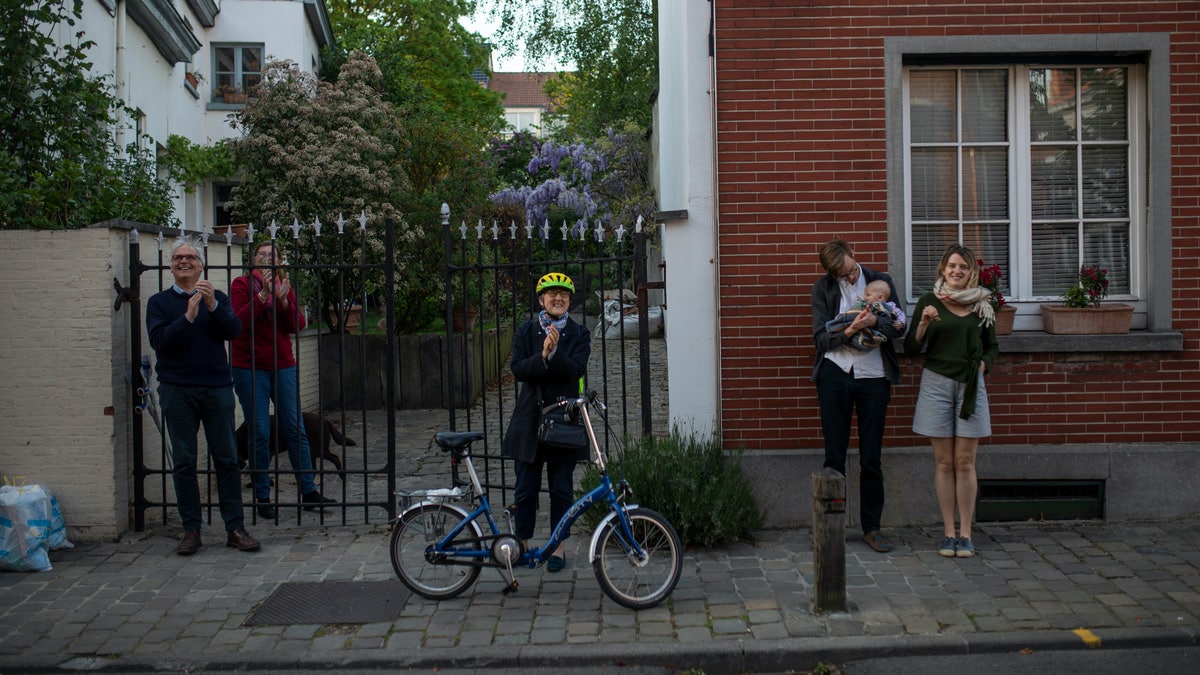
Family members applaud in support of the medical staff who are working in the wake of the COVID-19 outbreak during a partial lockdown against the spread of the coronavirus in Brussels, Tuesday, April 21, 2020. (AP Photo/Francisco Seco)
Throughout the month of May, the government will gradually ease further restrictions including a partial return to school and the reopening of parks and playgrounds.
However, cafes and restaurants remain closed until at least June 6 as well as beauty salons, hairdressers, and tattoo parlors because physical distancing is not possible. Sporting and cultural events are suspended until June 30.
BOSNIA AND HERZEGOVINA
Population: 3.32 million
Coronavirus cases: At least 2,158
Coronavirus deaths: At least 120
Bosnia’s gradual exit from the coronavirus lockdown is well underway in May, as businesses slowly have begun to reopen.
The country implemented a nationwide state of emergency on March 17 after the Federation and the Serb Republic, its other autonomous half, separately introduced measures to slow the spread of the virus.
Wholesale trade businesses and retail shops, as well as hairdressers and cosmetic salons, reopened on May 1. Owners must provide disinfection of hands and footwear for customers and disinfect premises each day before opening.
The Serb Republic started easing restrictions on seniors and children on April 27, allowing them to leave their homes for at least three hours each workday. The state of emergency may end on May 20.
The Federation civil protection said kindergartens, dental clinics and restaurants and bars with outdoor patios and spaces might also reopen in mid-May.
ITALIAN TOWN PRINTING ITS OWN MONEY TO HELP RESIDENTS IN NEED DURING CORONAVIRUS LOCKDOWN
CROATIA
Population: About 4 million
Coronavirus cases: At least 2,209
Coronavirus deaths: At least 94
Croatia went into lockdown in mid-March, only allowing food stores, pharmacies and gas stations to remain open.
Prime Minister Andrej Plenkovic said on April 23 that the “epidemiological situation” was under control and the country could gradually reactive economic activities.
“But we must remain very cautious not to waste what we have so far achieved,” he told a cabinet session, according to Reuters.
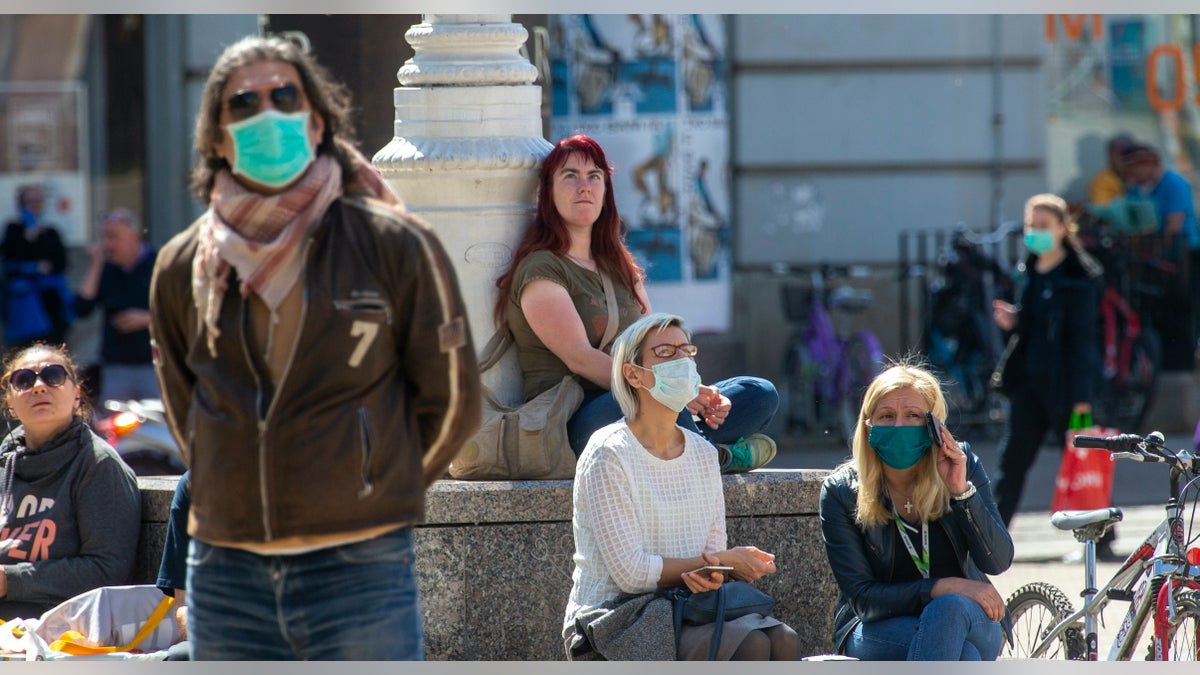
People, some wearing face masks to protect against coronavirus, watch preparations for the removal of a spire on Zagreb's Cathedral, in Zagreb, Croatia, Friday, April 17, 2020. The cathedral suffered significant damage during an earthquake in March. (AP Photo/Darko Bandic)
On April 27, all shops – except from those located in big shopping centers – and businesses that can provide services without requiring close contact with customers reopened. Libraries, bookshops and museums, as well as public transportation in cities, also began operating.
Hairdressers and other shops involving close physical contact reopened on May 4, but with specific protection measures. A week later – on May 11 – elementary schools opened their doors for the youngest students; bars and restaurants were allowed to operate only in their outside spaces. Big shopping centers reopened on that date.
Public events and large public gatherings remain banned.
CYPRUS
Population: About 1.17 million
Coronavirus cases: At least 903
Coronavirus deaths: At least 16
Cyprus slowly began easing its tight coronavirus lockdown by allowing some businesses to reopen in early May with more measures expected to be lifted later in the month.
Construction and related companies were the first to reopen for business, as well as smaller shops. A curfew restricting movement at night remains in place.

A swimmer in the clear waters of "Adams" beach in Ayia Napa, a seaside resort that's popular with tourists from Europe and beyond, on Sunday, May 10, 2020. With coronavirus restrictions gradually lifting, Cyprus authorities are mulling over ways to get holidaymakers back to the tourism-reliant island nation that officials say is conservatively estimated to lose at least 60% of its annual tourist arrivals. (AP Photo/Petros Karadjias)
Full easing of movement would occur starting May 21, more than two months after the island state imposed its tough regulations.
Meanwhile, a ban on commercial flights into and out of the country was extended until May 28. Only cargo planes, authorized repatriation flights, and some humanitarian flights have been exempt. The government hopes to have airports operating full schedules after June 9, depending on how the pandemic unfolds domestically and abroad.
CZECH REPUBLIC (CZECHIA)
Population: About 10.7 million
Coronavirus cases: At least 8,223
Coronavirus deaths: At least 284
The Czech Republic has taken it first steps toward easing its coronavirus restrictions with a five-stage plan that began April 20.
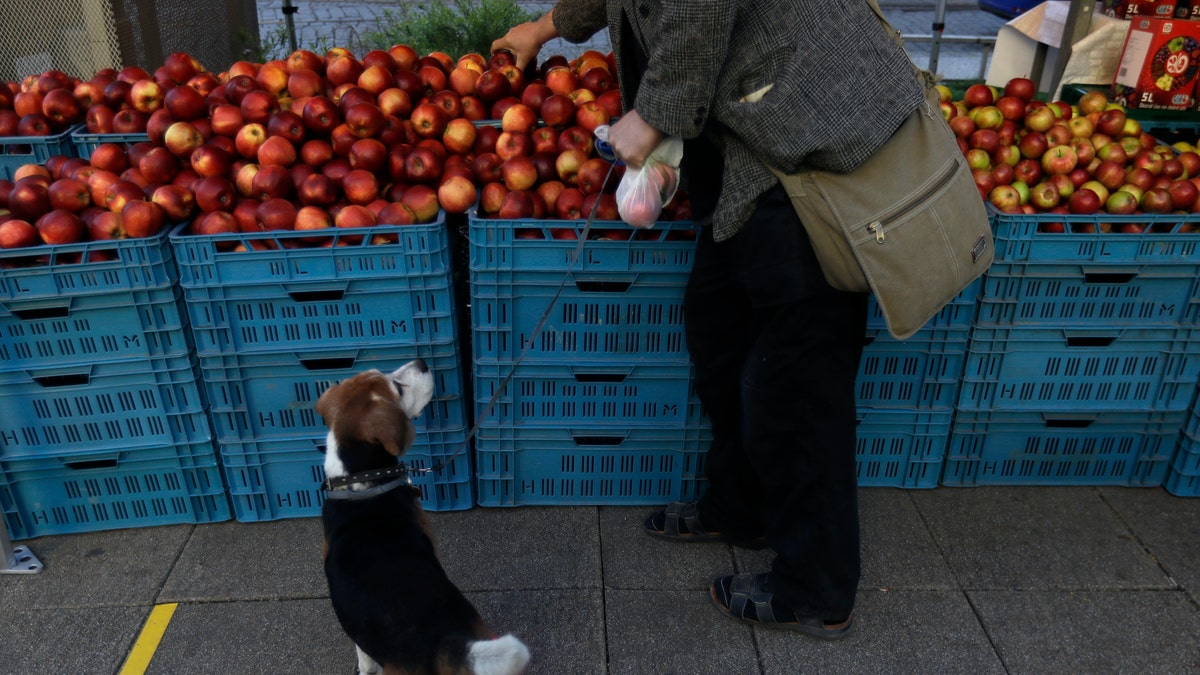
A man shops for apples as the farmers markets open in Prague, Czech Republic, Monday, April 20, 2020. Czech Republic has started to ease some of the restrictions that were applied in efforts to stem the spread of the new coronavirus. (AP Photo/Petr David Josek)
The country’s tough approach – which included a near lockdown of the country’s more than 10 million residents on March 12 – has prevented the uncontrolled spread of the virus.
Under its plan, Czech authorities reopened farmers’ markets, car dealerships, and other small businesses before slowly allowing residents to return to some form of normalcy.
In the final stage of the plan, tentatively scheduled for June 8, all businesses would be allowed to reopen, including bars, cafes, restaurants and hotels. However, officials have cautioned that restrictions could be re-imposed if there was a sudden surge in cases.
The country's borders with Slovakia and Austria could also reopen as soon as June 8, which would allow residents from the three countries to travel between them.
CORONAVIRUS IN ITALY: SAVING CHEESE TO SAVE LIVELIHOODS
DENMARK
Population: About 5.8 million
Coronavirus cases: At least 10,789
Coronavirus deaths: At least 533
Denmark was one of the first European nations to announce a lockdown and is now among the first slowly relaxing it. On March 11, the government closed schools, restaurants and nonessential businesses and banned gatherings of more than 10 people. The borders were shut to most foreigners.
Just over a month later, on April 15, the country’s children returned to the classroom – the first step in the country’s gradual easing of the lockdown. Days later, some businesses were allowed to reopen, including hairdressers, which saw a rush of appointments and visits. Other places allowed to open include tattoo parlors, physiotherapists and dentists.
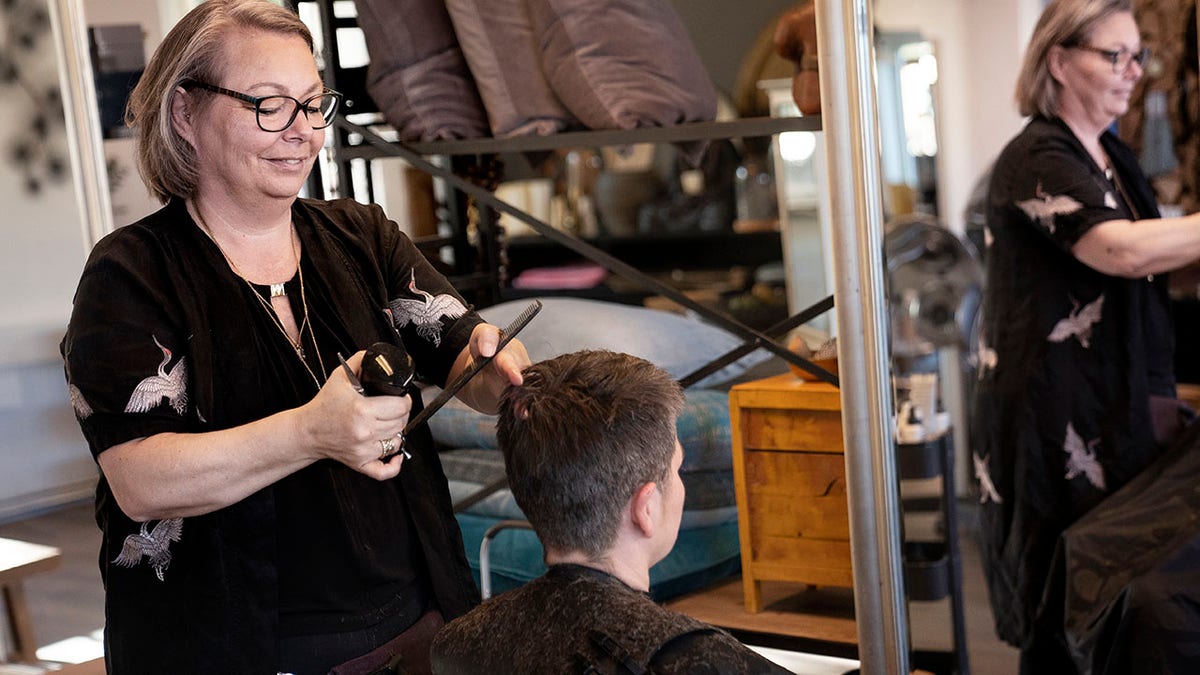
Christel Lerche cuts a customer's hair at Hot N Tot Hairdressers, in Bagsvaerd, Denmark, Monday, April 20, 2020. Denmark began reopening hair salons, dentists, physiotherapists, tattoo parlors and driving schools, among others on Monday which had previously been closed amid the coronavirus pandemic. (Liselotte Sabroe/Ritzau Scanpix via AP)
The opened businesses must follow new health guidelines. Zoological gardens and animal parks reopened May 1.
Malls, schools for the older students, and restaurants will be allowed to reopen throughout May and into June.
The country’s third phase of reopening will allow museums, amusement parks and cinemas to reopen on June 8. Additionally, the maximum number of people allowed to meet in public will rise to between 30 to 50.
Night clubs, music venues and gyms will remain shut until the fourth phase of reopening, which is expected to start by the beginning of August.
DANES RUSH FOR HAIRCUTS AFTER GOVERNMENT TAKES NEW STEPS IN EASING CORONAVIRUS RESTRICTIONS
ESTONIA
Population: About 1.3 million
Coronavirus cases: 1,751
Coronavirus deaths: At least 61
The Baltic nation of Estonia began to gradually ease restrictions on its residents, opening health care services after more than a month under strict isolation measures meant to curb the spread of the new coronavirus.
Movement restrictions were eased for the residents of Saaremaa, the largest island with some 32,000 inhabitants, on May 4. Mainland Estonian residents are free to move between islands two weeks later, provided the COVID-19 situation in the country is “showing signs of easing.”
Meanwhile, the government’s three-step strategy will allow secondary schools to reopen after May 15 so students can prepare for year-end exams.
Open-air museums, outside sports, and hobbies will be next permitted to resume, followed by weddings with a limited number of guests and shops in malls, Reuters reported.
FINLAND
Population: about 5.5 million
Coronavirus cases: at least 6,145
Coronavirus deaths: at least 287
Finland is slowly returning to a “new normal” by gradually pulling back coronavirus restrictions.
The Nordic country introduced a lockdown in mid-March, that closed restaurants, schools, and public places in an effort to curb the spread of COVID-19 infections.
On May 14, elementary and secondary schools reopened – two weeks before summer break starts in early June – with new strict distancing and hygiene guidelines for students and teachers. Essential travel to countries in Europe’s Schengen open-border area also restarted.
Restaurants will open gradually from June 1, as well as public services like libraries, theaters, and sports facilities. A ban on public meetings will be relaxed from a maximum of 10 people to 50 people.
Professional sports events and competitions also will restart from June 1, under “special arrangements,” including restrictions on the crowd.
FRANCE OUTLINES PLAN TO LIFT CORONAVIRUS LOCKDOWN, SPAIN TO ANNOUNCE ROADMAP TO REOPENING
FRANCE
Population: About 67 million
Coronavirus cases: At least 178,349
Coronavirus deaths: At least 26,994
France remains one of the hardest-hit countries on the European countries, however, in late April its government rolled out plans to ease lockdown restrictions and restart the economy.
Primary school students began to trickle into their classrooms on May 11 after more than two months homeschooling. Secondary school children are due back on May 25.

A woman wearing a face mask walks in a street during nationwide confinement measures to counter the Covid-19, in Paris, Tuesday, April 28, 2020. France continues to be under an extended stay-at-home order until May 11 in an attempt to slow the spread of the COVID-19 pandemic. (AP Photo/Thibault Camus)
Additional restrictions – including allowing hairdressers and nail salons to reopen their doors – were lifted as part of France’s roadmap to reopening.
Bars and restaurants remain closed and public gathers of more than 10 people are still banned. Beaches are closed until June 1.
The French soccer and rugby seasons were outright canceled.
GERMAN UNDERGROUND HAIRDRESSING SALONS SHUT DOWN BY POLICE DURING CORONAVIRUS
GEORGIA
Population: About 3.7 million
Coronavirus cases: 647
Coronavirus deaths: 11
A nationwide ban on the movement of private vehicles in the former Soviet country of Georgia was lifted on April 27. Grocery markets opened and all online and delivery services resumed operations on the same day.

Believers wearing protective masks gather outside a church during a service, which marks the Orthodox feast of Palm Sunday, amid the coronavirus disease (COVID-19) outbreak in Marneuli, Georgia April 12, 2020.
Meanwhile, the lockdown in the capital, Tbilisi, was lifted in early May, allowing shops to gradually open. The same restriction was lifted in another large city, Rustavi, on May 14.
Georgia will reopen to foreign tourists on July 1, with domestic tourism resuming on June 15.
The nationwide state of emergency remains in place until May 22 and includes a night curfew, the closure of restaurants, cafes, and most shops. A ban on gatherings of more than three people remains in place.
GERMANY
Population: About 83.7 million
Coronavirus cases: At least 173,274
Coronavirus deaths: At least 7,780
Unlike other European countries, Germany stopped short of mandating a stay-at-home order for the country’s more than 83 million residents. Instead, it issued strict social distancing measures on March 22.
Public gatherings of more than two people were banned, except for families and those who live together. Restaurants not offering food delivery or pick-up were ordered closed, along with other non-essential shops. Exercising alone outside was allowed and schools were closed. Meanwhile, the states of Bavaria and Saarland put their residents on lockdown.

People walk to a shopping center as many smaller stores are allowed to open in Essen, Germany, Monday, April 20, 2020. Europe's biggest economy starts reopening some of its stores and factories after weeks of lockdown due to the new coronavirus outbreak. (AP Photo/Martin Meissner)
On April 20, Germany took its first step to gradually restart public life by allowing retailers with a surface area of up to 8,600 square feet, along with car and bicycle dealers, and bookstores to reopen. Social distancing and new health rules remained in effect.
Despite a spike in cases, the country’s 16 state governments – who are responsible for imposing and loosening lockdowns – gradually allowed restaurants, schools, gyms, and other facilities to reopen. Social distancing and new health rules remained in effect.
Germany’s border with Luxemburg will reopen May 16, while plans are being drawn up to end the country’s checks at the Danish border. Additionally, borders crossings with France, Switzerland and Austria will be opened as well, with the aim to restore free travel across Germany’s borders on June 15.
GERMANY REOPENS SOME SHOPS IN FIRST STEP TO RESTART PUBLIC LIFE AMID CORONAVIRUS
GREECE
Population: About 10.7 million
Coronavirus cases: At least 2,744
Coronavirus cases: At least 152
The Greek government, which handled the outbreak of the virus better than some of its neighbors, began to ease lockdown measures over a 45-day period starting on May 4.
Small businesses reopened and a strict stay-at-home order ended on that day, with Greeks no longer having to carry a self-written document certifying they are outdoors for one of six specific reasons.
This was slowly followed by the opening of larger businesses, schools, some hotels and tourism properties on May 11.
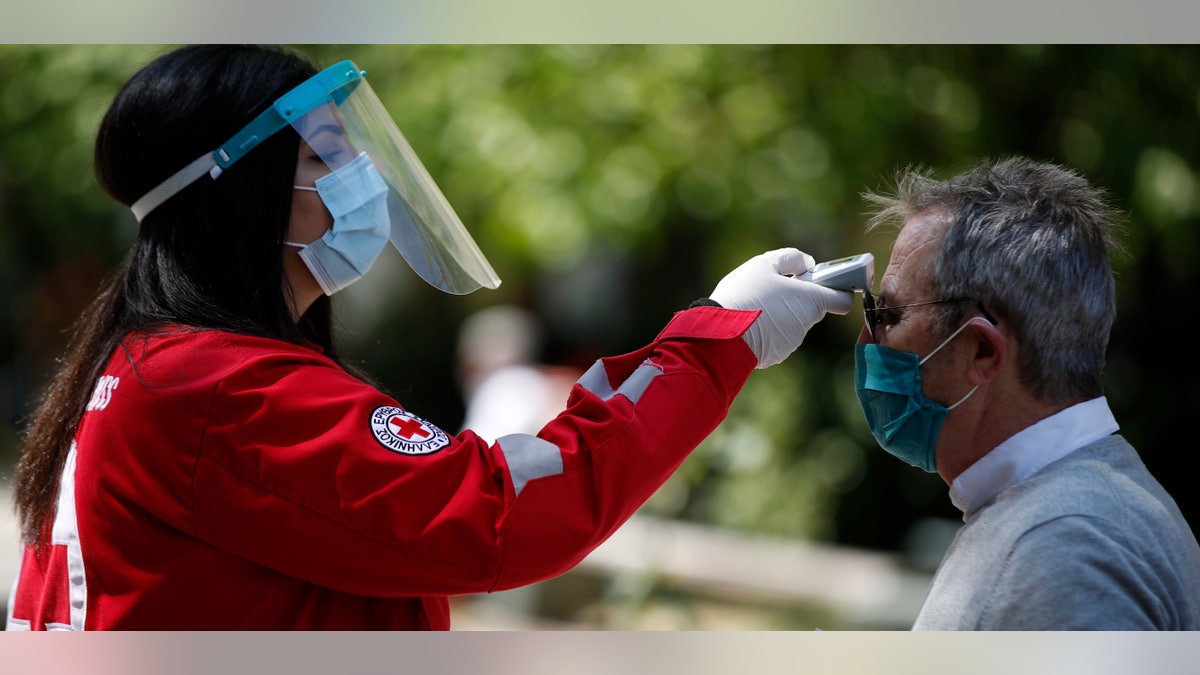
A Red Cross worker checks people's temperatures during the measures against the new coronavirus at the main entrance of a lower court complex buildings in Athens on Tuesday, April 28, 2020. Lower courts and the state property registry reopened Tuesday, beginning an easing on lockdown measures due the COVID-19 in Greece, where infection rates have remained relatively low. A broader and staggered easing program will start on May 4. (AP Photos/Thanassis Stavrakis)
Officials said schools will reopen before summer for students in the final year of schooling, with a rollout to follow for younger grades. Churches will be accessible for private prayers and people can later attend services on May 17.
HUNGARY
Population: About 10 million
Coronavirus cases: At least 3,341
Coronavirus deaths: At least 430
Hungary kept the country’s businesses shut and residents mostly at home starting in mid-March in an effort to curb the spread of the coronavirus.
The country began to loosen those restrictions in May by allowing smaller retail outlets to open first, followed by the gradual reopening of hotels, restaurants and coffee shops.
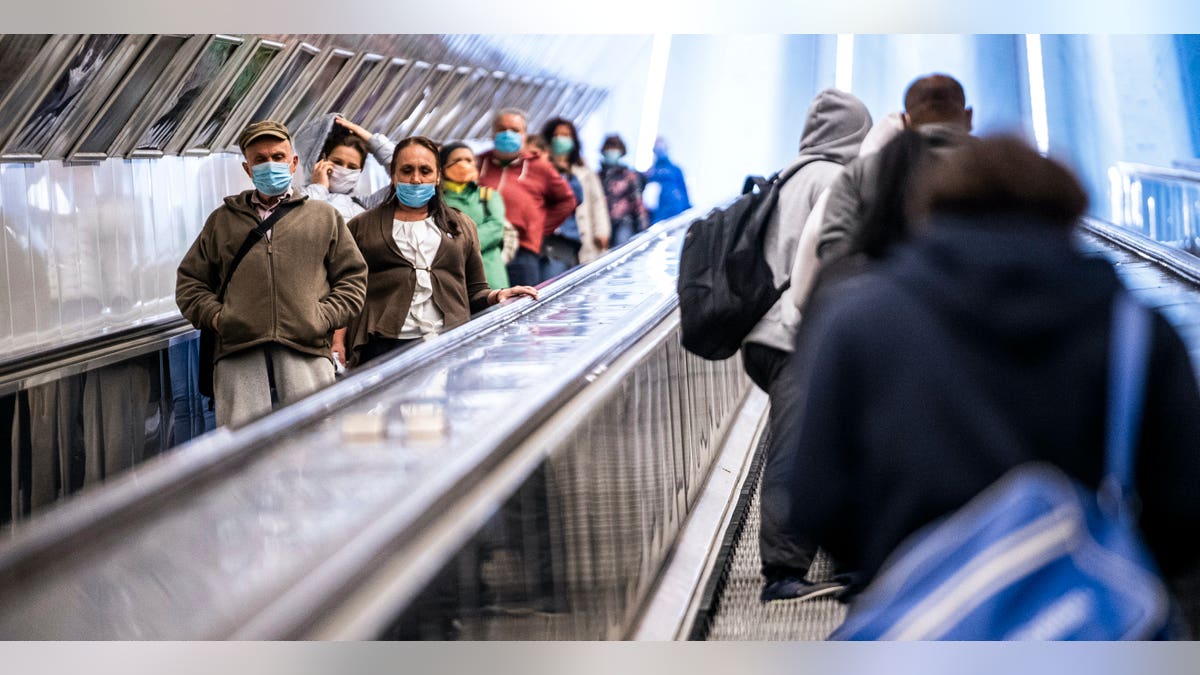
Passengers wear face masks on the escalator of the Szell Kalman station in Budapest, Hungary, Monday, April 27, 2020. From today face masks are mandatory in Budapest when shopping and at public transport due to the coronavirus outbreak. (Zsolt Szigetvary/MTI via AP)
Hungarians entering a business or restaurant must wear face masks of some kind, while stricter health protocols will be set in place – probably for the whole year.
ICELAND
Population: about 364,134
Coronavirus cases: at least 1,802
Coronavirus deaths: at least 10
Iceland reopened high schools, hair salons, dentists, and other businesses after six weeks of lockdown in early May.

This picture taken 29 April, 2020, shows peopled gatering at a restaurant in Reykjavík after the country recorded days of zero new cases of COVID-19.
Additionally, the government excepts to start easing restrictions for visitors arriving from overseas no later than June 15.
Under a plan still being developed by the authorities, travelers would be given a choice between a test for COVID-19 upon arrival in Iceland or a two-week quarantine, it said.
ITALY FREES SOME MAFIA BOSSES FROM PRISON OVER CORONAVIRUS, REPORTS SAY
ITALY
Population: Around 60 million
Coronavirus cases: At least 221,216
Coronavirus deaths: More than 30,900
Italy, once considered the epicenter of the coronavirus pandemic in Europe, has grappled with easing restrictions on its more than 60 million residents as the number of daily infections continues to slowly drop.
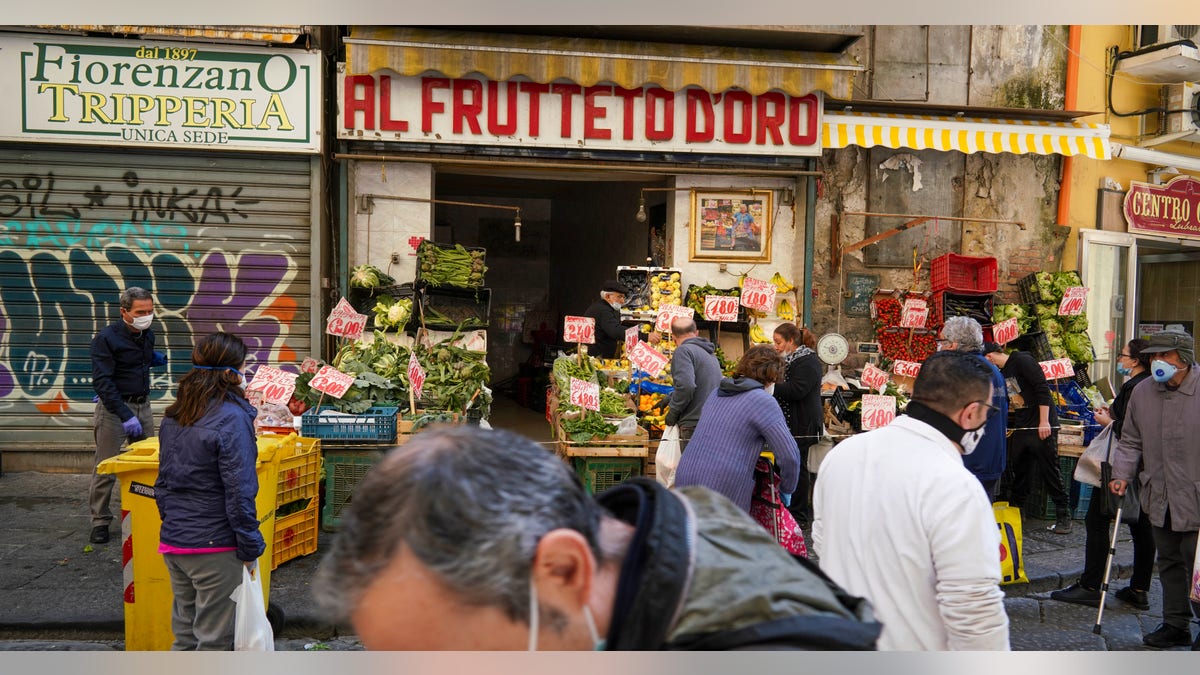
People buy fruit and vegetables at a shop in Naples, Monday, April 27, 2020. Region Campania allowed cafes and pizzerias to reopen for delivery Monday, as Italy it is starting to ease its lockdown after a long precautionary closure due to the coronavirus outbreak. (AP Photo/Andrew Medichini)
After implementing sweeping measures in March and telling Italians to stay home and shutting schools, businesses and industries nationwide, residents were allowed some freedoms more than a month later.
In late April, Italy allowed bookshops, laundries and children’s clothing stores to reopen in some regions, while forestry workers and IT manufacturers were allowed back to work.
Weeks later, people were allowed to visit their relatives in small numbers and parks, factories and building sites reopened. However, schools will not restart classes until September.
Funerals have been allowed to resume, with no more than 15 people in attendance.

People line up during a free distribution of protective masks against COVID-19 by volunteers of the Chinese Evangelical Christian Church, in Rome, Wednesday, April 22, 2020. (Cecilia Fabiano/LaPresse via AP)
Individual sports resumed practice on May 4, however, professional sports teams – including Italy’s Serie A league – can only resume training after May 18.
Bars and restaurants have allowed to open for takeout service, however dine-in service is expected to begin June 1. More retail stores will reopen May 18.
LATVIA
Population: About 1.92 million
Coronavirus cases: at least 951
Coronavirus deaths: at least 19
Latvia introduced restrictions in March to halt the spread of the coronavirus. More than a month later, it began to ease a string of measures, including allowing public gatherings of up to 25 people.
Sports activities without physical contact are also now allowed, while libraries and shops will reopen as well.
The country’s state of emergency was extended until June 9. Latvia and the other Baltic states announced plans to resume internal cross-border travel for their citizens from May 15.
LITHUANIA
Population: About 2.8 million
Coronavirus cases: At least 1,505
Coronavirus deaths: At least 44
Shops, open-air restaurants, libraries, hairdressers and museums were allowed to reopen in Lithuania in mid-April as the government sought to ease the restrictions imposed a month before.
Reopened businesses will need to limit the number of customers on their premises to no more than one person per 10 square meters.
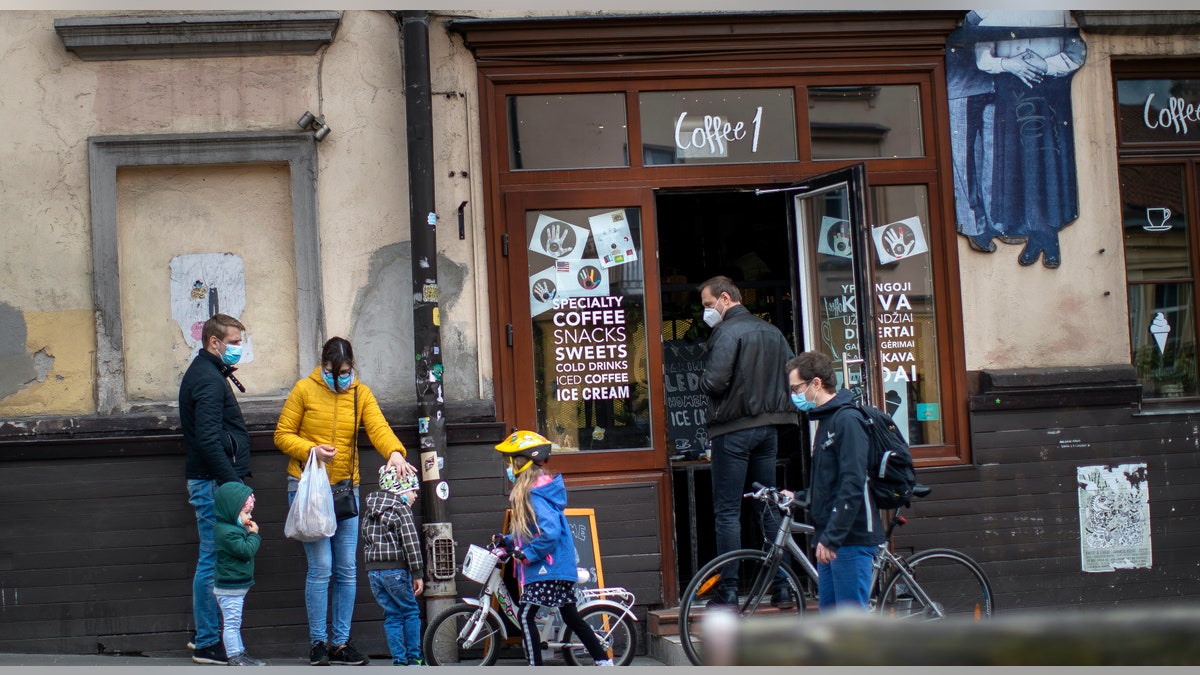
People wearing face masks to protect themselves against the spread of the new coronavirus queue up to buy coffee at a shop in Vilnius, Lithuania, Saturday, April 25, 2020. (AP Photo/Mindaugas Kulbis)
Educational institutions and nonemergency medical services remain closed. All Lithuanians are required to wear masks outside as a preventative measure against the spread of COVID-19
MALTA
Population: About 493,559
Coronavirus cases: At least 508
Coronavirus deaths: At least 6
Malta, the smallest country in the European Union, allowed many shops to reopen in early May, more than five weeks after restrictions were imposed to curb the spread of the coronavirus.
Gatherings up to four people were allowed, however, social distancing remains in place, and masks must be worn to prevent a resurgence of the disease.
The government said bars, restaurants, and hairdressers must stay shuttered while the airport will remain closed at least until the end of May. Schools will not reopen this academic year.
GERMANY'S MERKEL ACCUSES RUSSIA OF HACKING HER EMAIL ACCOUNT
MONACO
Population: About 38,700
Coronavirus cases: At least 96
Coronavirus deaths: At least 4
The government of Monaco's roadmap to restart its economy saw some retail shops open in early May, with a limit of 1 person per 4 square meters and mandatory use of masks. Hairdressers are by appointment only, while places of worship reopened with social distancing measures in place.
Schools opened on May 11, with priority given to high school students and those taken exams. The rest of the grades will continue throughout the month.
Restaurants, cafes and hotels will remain closed until June and will only open if “sanitary conditions are observed during the first two phases.” Cinemas, museums, beaches and public pools will remain closed.
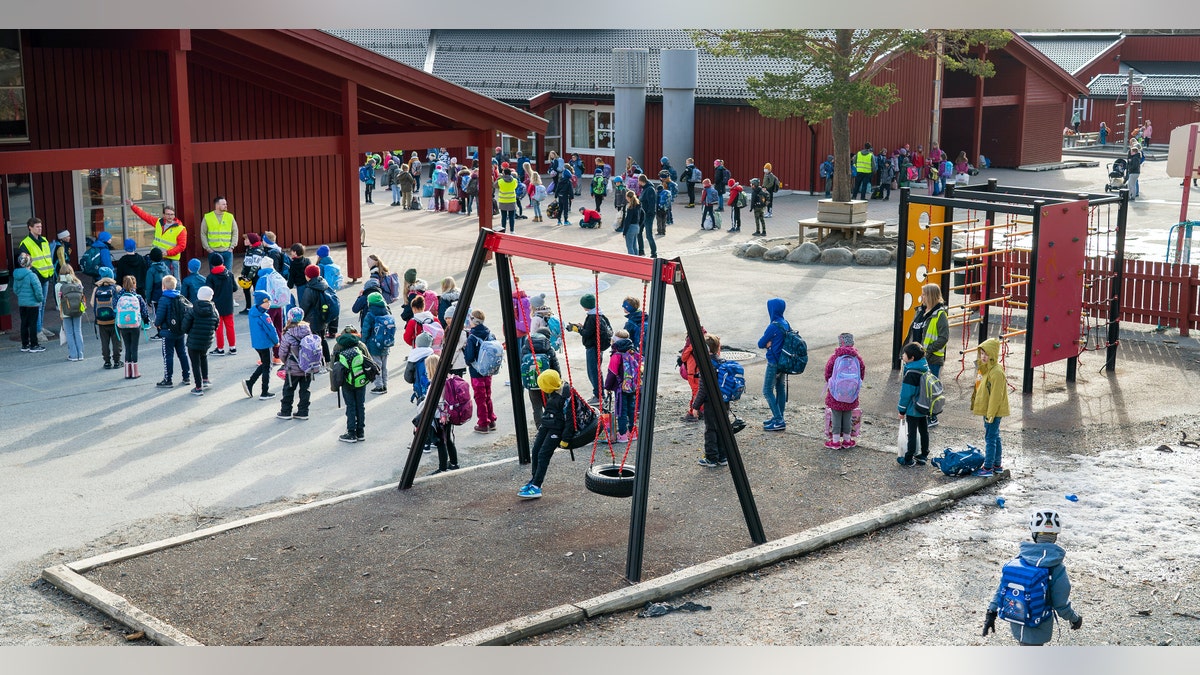
Vikasen school in Trondheim, Norway, as schools opened their doors on Monday, April 27, 2020. All students are divided into groups, must bring their own school equipment, and they are trained to stay one meter away from fellow pupils.(Gorm Kallestad / NTB scanpix via AP)
MONTENEGRO
Population: About 631,000
Coronavirus cases: At least 324
Coronavirus deaths: At least 9
Montenegro closed its borders, airports and seaports, shut schools and banned all public gatherings in an effort to curb the spread of the coronavirus in March.
As the rate of infection and deaths remained low, the government in mid-April cautiously eased the measures with health authorities deciding they would shorten a curfew and allow shops to work longer hours.
NETHERLANDS
Population: About 17.3 million
Coronavirus cases: At least 43,410
Coronavirus deaths: At least 5,581
As part of its four four-month plan to phase out social restrictions, Dutch schools were slowly reopened on May 11 with classes split and rotated to enable greater distancing.
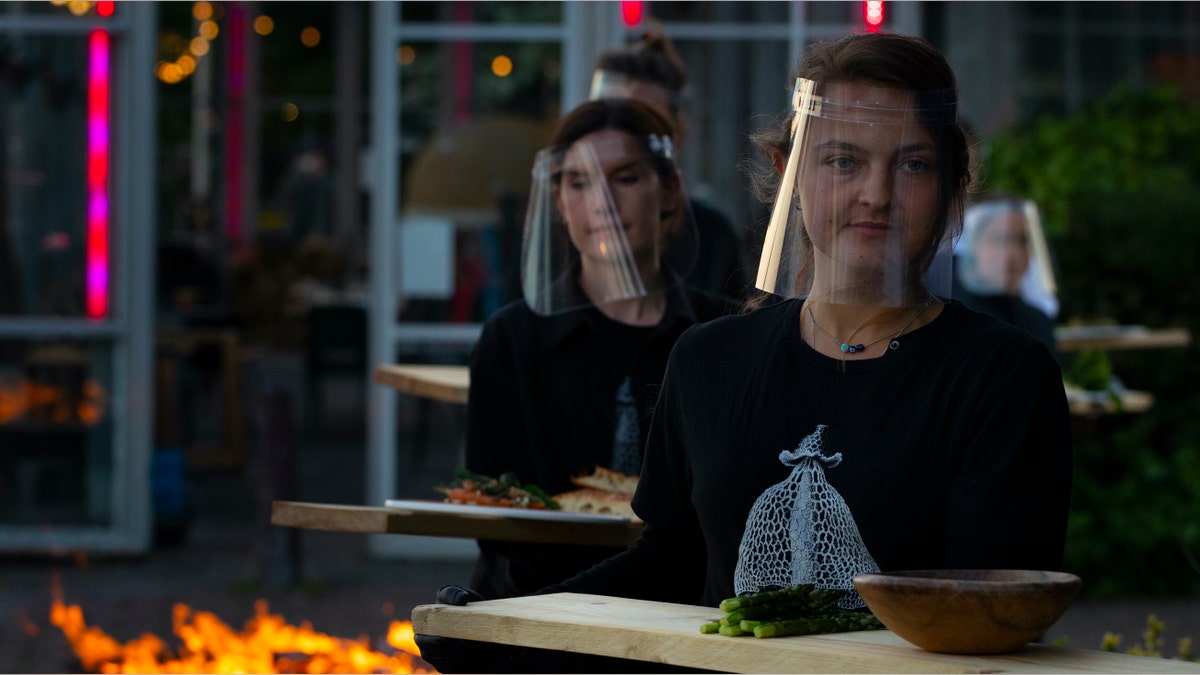
Staff at the Mediamatic restaurant serve food to volunteers seated in small glasshouses during a try-out of a setup which respects social distancing abiding by government directives to combat the spread of the COVID-19 coronavirus in Amsterdam, Netherlands, Tuesday, May 5, 2020. (AP Photo/Peter Dejong)
The country’s plan will then expand in stages through Sept. 1. However, measures could be ramped back up if there is a resurgence of infections.
If COVID-19 cases continue to fall, lockdown restrictions could be further lifted in September to include gyms, saunas, sex clubs, coffee shops and casinos. Face masks will be compulsory on public transport from June 1.
NORWAY
Population: About 5.4 million
Coronavirus cases: At least 8,158
Coronavirus deaths: At least 229
Norway implemented a strict two-week lockdown on public life on March 12, and it was quickly extended through Easter. The government closed schools, restaurants, cultural events, gyms and tourist attractions. It also closed its borders to outside travelers.
On April 20, Norway began to lift restrictions “little by little” by opening kindergartens before moving on to higher grades “before summer.” Universities and hair and beauty salons are expected to reopen in late April.
However, citizens are will required to work from home and the ban on sports and festivals remained in place until at least June 15.
POLAND
Population: about 38 million
Coronavirus cases: At least 17,062
Coronavirus deaths: At least 847
Poland began to ease its coronavirus-linked restrictions in early May by allowing hotels, shopping centers and kindergartens to reopen.
Restaurants and hairdressers will open on May 18.
The easing of further restrictions came amid a dispute between the government and opposition over how and when to hold elections which were originally scheduled for May 10.
PORTUGAL
Population: about 10.28 million
Coronavirus cases: At least 28,143
Coronavirus deaths: At least 1,175
Portugal began a three-phase plan in early May that will allow people to more freely leave their homes after a six-week lockdown.
Hairdressers, small neighborhood shops, car dealerships and bookshops were the first to reopen, but they must follow strict safety and capacity restrictions.

Miguel Coelho, the local parish council president, hands out red carnations, symbol of the April 25th Portuguese revolution, while trying to keep social distance, in Lisbon’s Mouraria neighborhood, Saturday, April 25, 2020. Portugal marks Saturday the anniversary of the 1974 revolution that restored democracy in the country, this year without the celebrations that always gather hundreds of thousands due to the measures to prevent the spread of the new coronavirus. (AP Photo/Armando Franca)
The use of masks is obligatory in enclosed public spaces like supermarkets and on public transport, with rule-breakers risking fines of up to 350 euros.
Remote working is still recommended where possible, and gatherings must be limited to 10 people.
RUSSIA
Population: about 144.5 million
Coronavirus cases: At least 242,271
Coronavirus deaths: At least 2,212
Russia is the second-hardest hit country, with only the United States recording more positive COVID-19 cases.
However, despite this tally, reached in only a matter of weeks, President Vladimir Putin began to ease some lockdown restrictions to revitalize the country’s economy, urging regional governors to allow people to take walks and exercise.
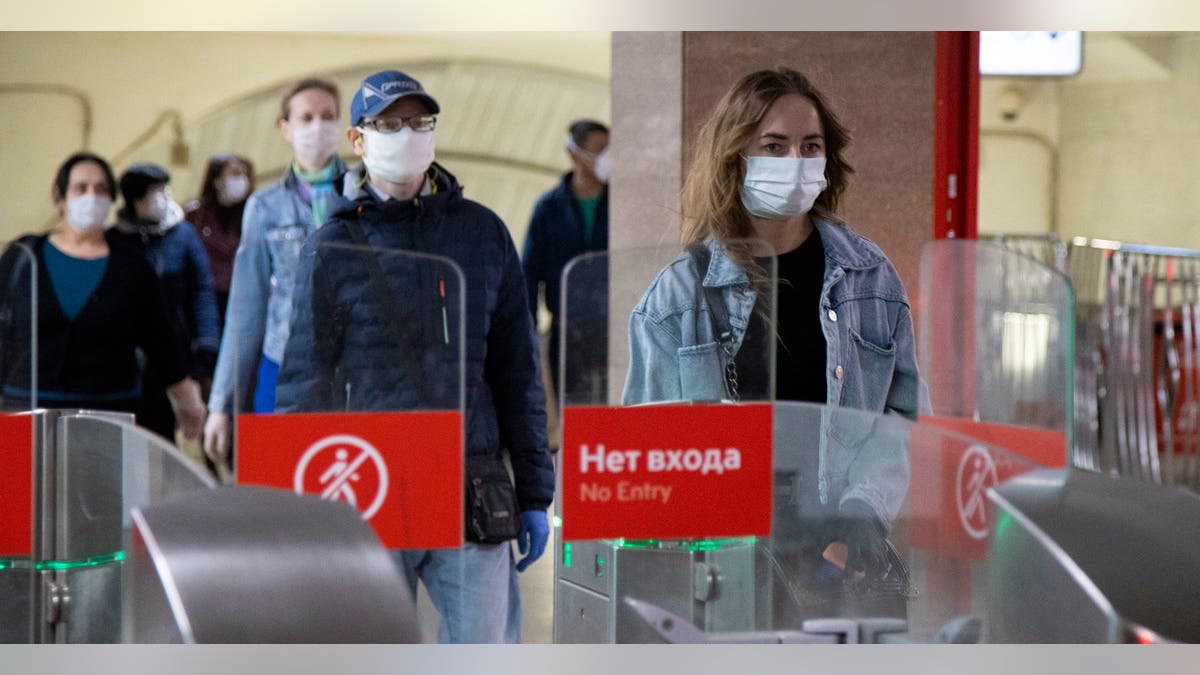
People wearing face masks and gloves to protect against coronavirus, observe social distancing guidelines as they pass through the turnstiles of the subway in Moscow, Russia, Tuesday, May 12, 2020. From Tuesday onward, wearing face masks and latex gloves is mandatory for people using Moscow's public transport. President Vladimir Putin on Monday declared an end to a partial economic shutdown across Russia due to the coronavirus pandemic, but he said that many restrictions will remain in place. (AP Photo/Alexander Zemlianichenko)
Large otherings remain prohibited and Russians who are older than 65 or have chronic illnesses must remain at home.
Putin emphasized restrictions must be lifted gradually to avoid triggering a new wave of contagion.
SERBIA
Population: About 7 million
Coronavirus cases: At least 10,243
Coronavirus deaths: At least 220
The Serbian government, which introduced a national lockdown in March, will restart bus and rail services and allow commercial flights starting in May.

A hairdresser wearing a mask to protect against coronavirus, cuts a customer's hair, at a reopened hair salon in Belgrade, Serbia, Monday, April 27, 2020. The authorities have started a partial easing of the strict rules by reopening some businesses and allowing people over 65 years old limited movement, but they also announced an 83-hour curfew for the upcoming May Day weekend. (AP Photo/Darko Vojinovic)
Shopping malls, cafes and restaurants will also reopen on condition they maintain social distancing practices.
The government has already allowed small businesses to open, shortened a night curfew, and eased a 24-hour lockdown for people aged 65 and above.
SLOVAKIA
Population: About 5.45 million
Coronavirus cases: At least 1,469
Coronavirus deaths: At least 27
Slovakia, which has seen fewer cases and deaths than many of its neighboring countries, reopened all shops outside malls, hotels, museums, galleries, and outdoor tourist attractions on May 6.
Religious services and weddings were also allowed to restart with a limited number of guests.
Schools remain closed, however, and international passenger travel is still no possible. People returning from abroad must go to state-run quarantine centers for 14 days.
SLOVENIA
Population: About 2 million
Coronavirus cases: At least 1,408
Coronavirus deaths: At least 86
Slovenia is gradually loosening its coronavirus restrictions nearly a month after the country locked down to curb the spread of the disease.
On April 27, car service centers and certain shops reopened, while outdoor sports like tennis and golf were allowed to resume.
Hairdressers and beauty salons will reopen on May 4. However, people still need to wear face marks whenever entering an indoor public space.
The government has not announced any decision to reopen schools, hotels, bars and restaurants.
SPAIN
Population: About 46 million
Coronavirus cases: More than 228,000
Coronavirus deaths: At least 26,920
Spain, arguably among the hardest-hit countries in Europe, began its four-phase approach to a "new normal" in early May by allowing children under 14 to go outside for an hour a day

A man walks his dogs past a closed bar in Madrid, Spain, Tuesday, April 28, 2020. Official statistics show that Spain's unemployment rate rose to 14.4% in the first quarter of 2020, reflecting only the partial impact of the new coronavirus pandemic in Spain's job market. Spain's left-wing coalition government is poised to announce Tuesday further steps to ease the 7-week lockdown, one of the world's strictest. (AP Photo/Paul White)
On May 11, street stores – but not malls – were allowed to open as long as they have taken necessary precautions.
Tourist accommodations like hotels and hostels can also reopen, however, their common areas must remain closed.
In Phase Two, restaurants, museums, and monuments will allow visitors up to a third of normal capacity. Meanwhile, educational establishments will reopen for children under age six whose parents are both at work, for children who have fallen behind in their studies, and for students to sit university entrance exams. Schools will not fully reopen before September.
The rollback will occur at different speeds in the country’s provinces. Each will be measured according to “markers,” such as the number of infections, the economic status of people in the area, and the local health service’s capacity, before advancing to the next phase.

Commuters wearing face masks to protect against coronavirus at the platform of Atocha train station in Madrid, Spain, Monday, April 13, 2020. Confronting both a public health emergency and long-term economic injury, Spain is cautiously re-starting some business activity to emerge from the nationwide near-total freeze that helped slow the country's grim coronavirus outbreak. (AP Photo/Bernat Armangue)
The government began easing its restrictions on residents on April 13 by allowing some non-essential workers to return to their jobs.
SPANISH TAXI DRIVERS, CHAUFFEURS GO THE EXTRA DISTANCE TO HELP AMID CORONAVIRUS PANDEMIC
SWITZERLAND
Population: About 8.6 million
Coronavirus cases: At least 30,412
Coronavirus deaths: At least 1,870
Switzerland took extreme measures to curb the spread, by effectively locking down the country on March 16. Nearly a month later – as the number of daily cases continues in a downward direction – the government announced a three-phase lifting of the lockdown which began April 27.
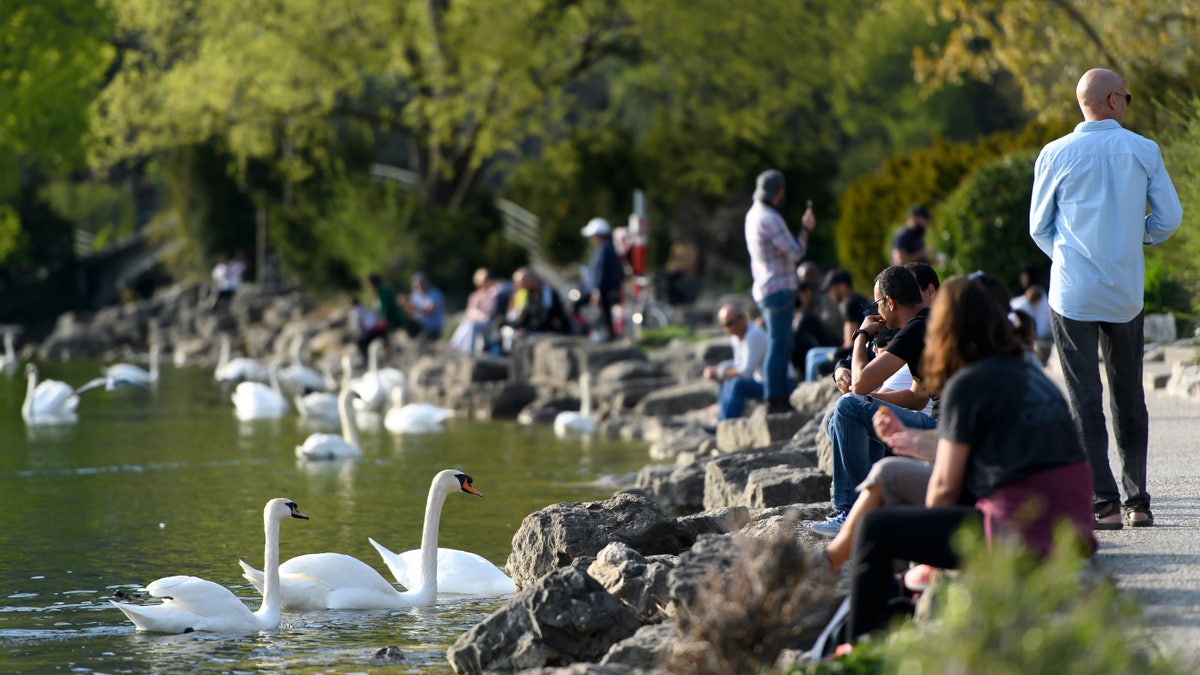
People enjoy the sun on the shore of Lake Biel during the state of emergency of the coronavirus disease (COVID-19) outbreak, in Biel, Switzerland, Monday, April 13, 2020. Countries around the world are taking increased measures to stem the widespread of the SARS-CoV-2 coronavirus, which causes the Covid-19 disease. (KEYSTONE/Anthony Anex)
The first phase includes reopening some non-essential businesses such as hairdressers, physiotherapists, medical and dental offices, while grocery stores and supermarkets also will be able to sell non-essential products again. Precautionary measures will remain in place and wearing masks will become obligatory.
The second phase of the plan, which began on May 11, saw schools for children of compulsory school age reopen. All stores and markets also reopened on that date.
The final phase, set for June 8, will see the reopening of upper secondary schools, universities as well as the possible lift of restrictions on entertainment and cultural events.
TURKEY
Population: About 82 million
Coronavirus cases: More than 140,000
Coronavirus deaths: More than 3,950
Turkey announced its “normalization plan” to ease coronavirus restrictions which saw malls, hairdressers, barbershops and hair salons to open on May 11. They must wear both surgical masks and transparent plastic face screens, and to use disposable towels and other single-use supplies.
The government has laid out strict operating guidelines for reopened businesses. Shopping malls must check entering customers for fevers and ensure everyone wears face masks. The number of customers allowed in at once is capped under a formula of one person per every 10 square meters (108 square feet) of floor space.
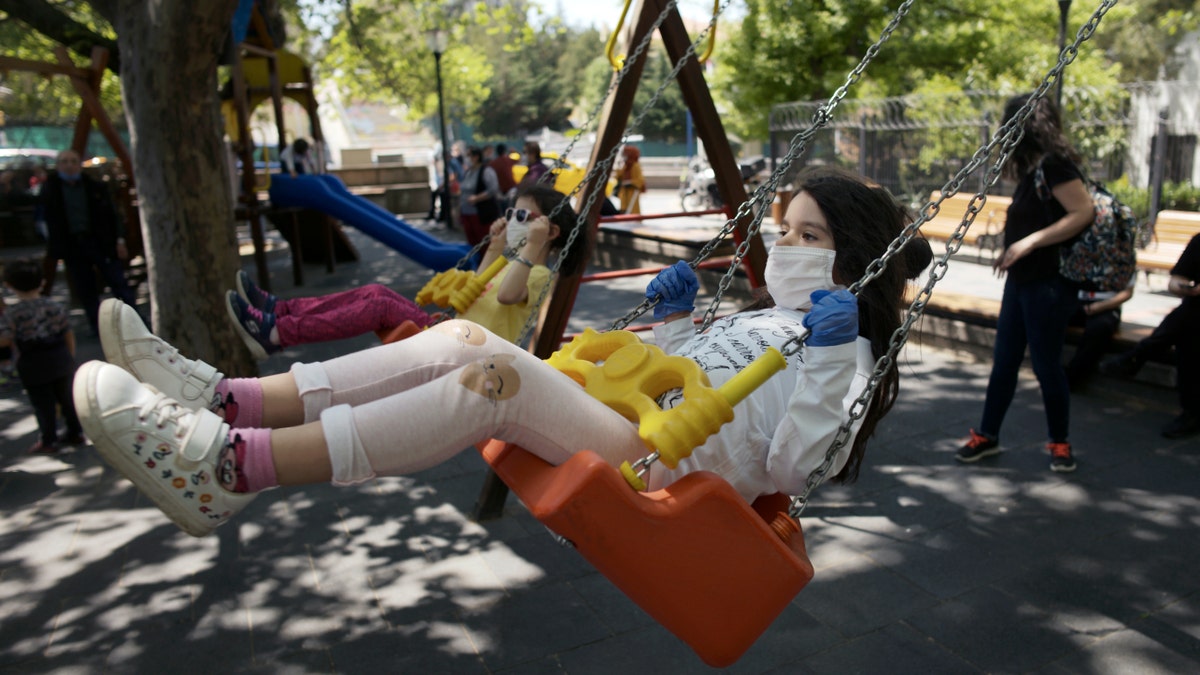
Children wearing face masks for protection against the coronavirus, play on swings in Kugulu public garden, in Ankara, Turkey, Wednesday, May 13, 2020. Parks filled with the sound of children as Turkey allowed those aged 14 and under to leave homes for the first time in 40 days. The country's youngest population were allowed to venture out for four hours between 11:00 am and 3:00 pm on Wednesday as Turkey eased some restrictions in place to fight to coronavirus outbreak.(AP Photo/Burhan Ozbilici)
Children under the age of 14 were also allowed to leave their homes for the first time in 30 days on May 13, while those between the ages of 15 to 20 will be allowed to leave their homes for a few hours on Friday.
The government warned that tougher measures will be reinstated if infections go up again.
UNITED KINGDOM
Population: About 66.65 million
Coronavirus cases: At least 230,983
Coronavirus deaths: At least 33,263
After seven weeks of lockdown, people in England were allowed to exercise more than once a year and with one person outside of their household, provided they remained at least 6 feet apart. It was the first step of a three-stage approach to ending the lockdown.

A customer shops near a social distancing sign at Osterley Garden Centre in London as the country is in lockdown to help stop the spread of coronavirus, Wednesday, May 13, 2020. Some of the coronavirus lockdown measures are being relaxed in England on Wednesday, with garden centres reopening but with extra measures such as social distancing. (AP Photo/Kirsty Wigglesworth)
If there is no new spike in infections, that will be followed in June by a return to class for some young school pupils, the reopening of nonessential shops and the return of televised sports, played behind closed doors. A third stage, penciled in for July at the soonest, would see the gradual reopening of restaurants, cafes, pubs, hairdressers, and other businesses.
The easing of restrictions applies only in England. The semi-autonomous governments of Scotland, Wales and Northern Ireland are going more slowly and sticking with the “Stay Home” message, partly because the epidemic is at different stages in different parts of the country.





















